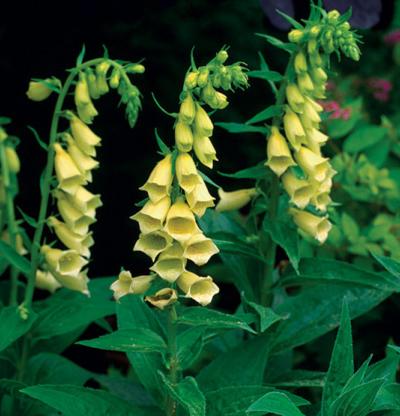





 Yellow foxglove (Digitalis grandiflora)
dij-ih-TAL-iss gran-dih-FLOOR-ah
Synonyms:
Digitalis orientalis
Genus:
Digitalis
Originating in mountainous woodland and stony habitats from Europe to western Asia, yellow foxglove is tolerant of dry shade but flourishes with moisture. Arising in midsummer from neat clumps of fine-toothed foliage, a mass of soft yellow open bells, speckled brown inside, blooms along one side of a 3-foot-tall stem. Usually described as a perennial, it is more accurate to call it a biennial or short-lived perennial. If the flowering stalk is cut down after blooms have faded, it may rebloom in the fall. When a few flower stalks are left, the plant self-seeds.
Noteworthy Characteristics:
These low-maintenance plants bloom with colorful, vertical drama. Yellow foxglove, like all species in this genus, contains poisonous properties and should never be eaten. Deer will avoid it.
Care:
Flourishes with moisture. Prefers part-shade in humus-rich soil, but can tolerate anything but extreme conditions.
Propagation:
Yellow foxglove (Digitalis grandiflora)
dij-ih-TAL-iss gran-dih-FLOOR-ah
Synonyms:
Digitalis orientalis
Genus:
Digitalis
Originating in mountainous woodland and stony habitats from Europe to western Asia, yellow foxglove is tolerant of dry shade but flourishes with moisture. Arising in midsummer from neat clumps of fine-toothed foliage, a mass of soft yellow open bells, speckled brown inside, blooms along one side of a 3-foot-tall stem. Usually described as a perennial, it is more accurate to call it a biennial or short-lived perennial. If the flowering stalk is cut down after blooms have faded, it may rebloom in the fall. When a few flower stalks are left, the plant self-seeds.
Noteworthy Characteristics:
These low-maintenance plants bloom with colorful, vertical drama. Yellow foxglove, like all species in this genus, contains poisonous properties and should never be eaten. Deer will avoid it.
Care:
Flourishes with moisture. Prefers part-shade in humus-rich soil, but can tolerate anything but extreme conditions.
Propagation:
By division. Sow seed in situ or in a cold frame in spring.
Problems:Southern blight, anthracnose, fungal leaf spot.
Copyright © www.100flowers.win Botanic Garden All Rights Reserved